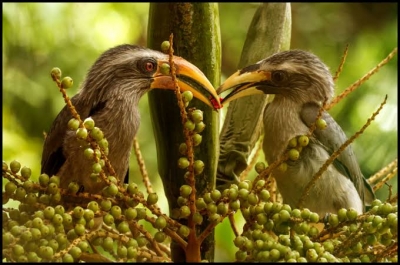
The cool and wet climate of the montane forests supports a wide variety of animal and plant species. The bio-system is richly endemic to many exotic species.
The montane rainforest trees are mostly evergreen. A few notable canopy trees characteristic to these forests include the wild durian, Ceylon ironwood, and Nageia. These wooded ecoregions are well-known for their fauna richness too. Of the total 78 mammal species found, ten are endemic.
The Asian highland shrew, Salim Ali’s fruit bat, Nilgiri langur, Malabar large-spotted civet, and the Nilgiri long-tailed tree mouse are just a few of the animal species found here. Other notable animals include the elephant, tiger, sloth bear, wild dog, leopard, and the endemic species like the Nilgiri tahr, the Nilgiri Macaque, and the lion-tailed Macaque. Of the 309 bird species, 13 species show endemism, including the Nilgiri wood-pigeon, Malabar grey hornbill, white-bellied treepie, and the white-bellied shortwing. The Aralam Wildlife Sanctuary, the Brahmagiri Wildlife Sanctuary, and the Indira Gandhi National Park are some of the notable forest conservation areas in the southern Western Ghats.
The trees of the southern Western Ghats’ deciduous forests are luxuriantly diverse. The mammals found are not strictly endemic and are more or less the same as in the montane ranges. The smaller threatened species of mammals include Jerdon’s palm civet, the grey slender loris, and the grizzled giant squirrel.
The Nilgiri wood-pigeon, the grey-headed bulbul, and the Rufous babbler are just a handful of the 322 native bird species of the ecoregion. Some of the critical protected forest reserves in the area are the Bandipur National Park, the Chinnar Wildlife Sanctuary, and the Eravikulam National Park.
Picture Credit : Google




